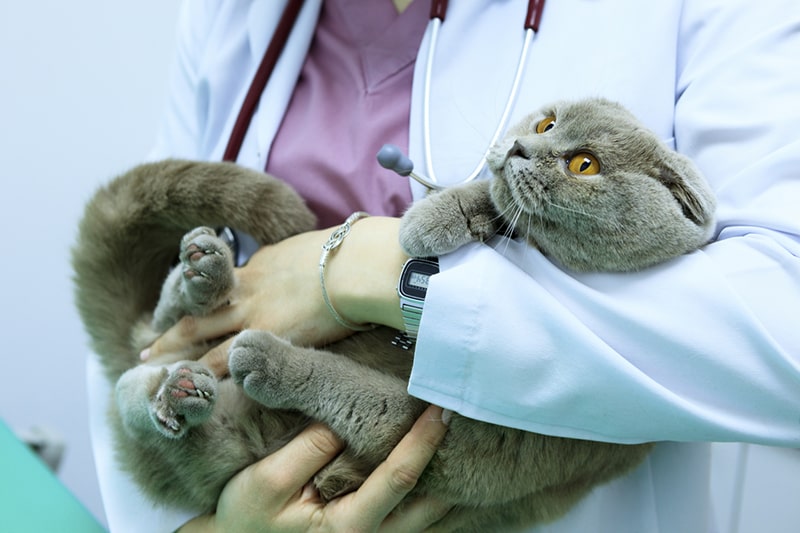Cat Behavior Problems and Training Tips
Even the best cat can act up from time to time. We break down some of the top behavior issues cat parents encounter and provide tips for training.
Our cats can't say, “Hey, I'm in pain!” But, they can let us know something is bothering them in other ways. It's important to know the signs of pain in cats so you can help your feline friend when they're suffering.
Just like us, cats can feel pain for all sorts of reasons. For instance, they may experience pain from an injury, such as a bruise, burn, laceration, or fracture. They may have pain due to a health condition, like arthritis, an upper respiratory infection (URI), dental disease, or an ear infection. Sometimes veterinary treatments like surgery can also result in temporary pain.
Fortunately for our cats, there are ways to help alleviate and manage pain. More often than not, the trick is knowing when our notoriously independent and stoic cats are in pain so we can get them the help they need. Cats tend to hide more than usual and mask their symptoms when something is bothering them, which can make it hard to tell when they're in pain.

It's a clear sign that something is wrong if your cat cries out, pulls away, or tries to escape when you touch a certain area. You should seek medical attention for your cat when this happens. However, other signs of pain in cats can be more subtle. Here are some signs that can indicate that something is wrong with your cat:
Cats can't tell us how much pain they're experiencing, but there are pain scales that can help. For instance, the Feline Acute Pain Scale developed by veterinarians at the Colorado State University uses psychological and behavioral cues to assess a cat's level of pain:
The Feline Grimace Scale created by veterinarians at the University of Montreal is another tool that can help determine how much pain a cat may be experiencing. This scale evaluates ear position, muzzle tension, position of the head and whiskers, and tightening around the eyes. For instance, a cat with flat ears rotated towards the side and squinted eyes may be experiencing a moderate to severe amount of pain.

This can't be stressed enough—never give your cat medication without talking to your veterinarian first. Only give your cat pain medications that have been prescribed for them. You should also be careful to follow the dosage amounts and timing carefully.
Cats are extremely sensitive to the side effects of pain medications, and they may be at increased risk for ulcers, blood clotting, and kidney or liver damage. TYLENOL® (acetaminophen), in particular, is very dangerous for cats and should not be given to them under any circumstances. As little as one pill can be deadly for a cat.
Avoid leaving your medications on low nightstands or countertops where they could get knocked over and swallowed by curious cats. Get more pet poison safety tips.
If your cat has arthritis, your veterinarian may prescribe non-steroidal anti-inflammatory drugs (NSAIDs) to reduce the pain. Although NSAIDs can cause kidney and liver issues with long-term use, these side-effects may be outweighed by the benefits. They can also be controlled somewhat with careful dosing and regular blood tests to assess kidney and liver values. Your veterinarian may also recommend a supplement called glucosamine, which can be beneficial to cats with arthritis.
If your cat has chronic pain from arthritis or another health condition, you can help improve their quality of life by making adjustments to their environment.

Another way to help a cat in pain is through massage, which is something you can do at home. Talk to your veterinarian to learn how to massage your cat safely, so you don't aggravate their pain.
Massage has both physical and mental benefits for your cat. It distracts them from their discomfort and helps alleviates boredom, which can lead to anxiety and depression. Additionally, massage is a great bonding experience for you and your cat.
If your cat has chronic pain, ask your veterinarian about alternative therapies. There are many different options available for cats these days, including acupuncture, therapeutic ultrasound, water therapy, cold laser therapy, physical therapy, and even emerging stem cell therapies.
For example, cats experiencing pain from arthritis may benefit from passive range of motion (PROM) exercises. PROM is a form of physical therapy that helps increase the motion of a joint by carefully stretching the muscles and tendons. You should have a trained veterinary physical therapist show you how to do these exercises so you can make sure you're doing them safely and won't harm your cat.
You may be surprised to know that you can get pet insurance coverage for alternative therapies. Get a free quote to learn more about the options available for your cat.
The information presented in this article is for educational and informational purposes only and does not constitute or substitute for the advice of your veterinarian.
(opens new window)